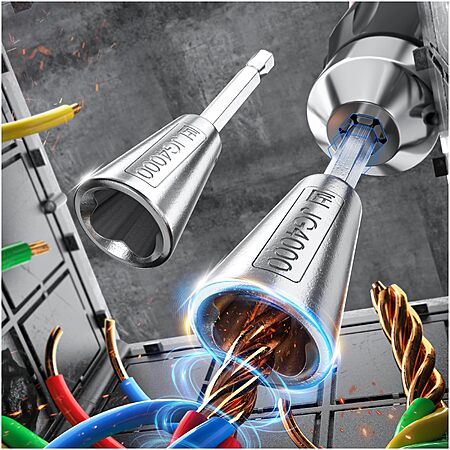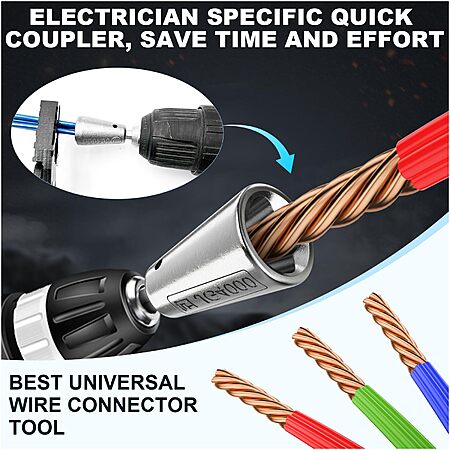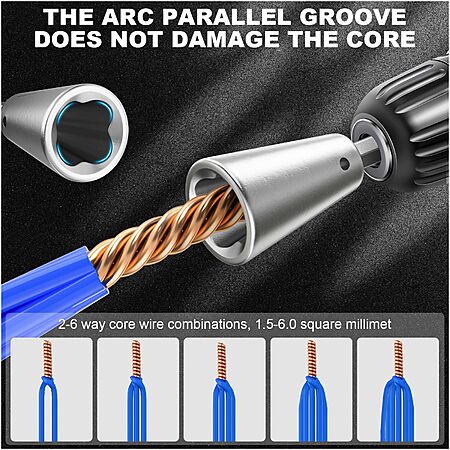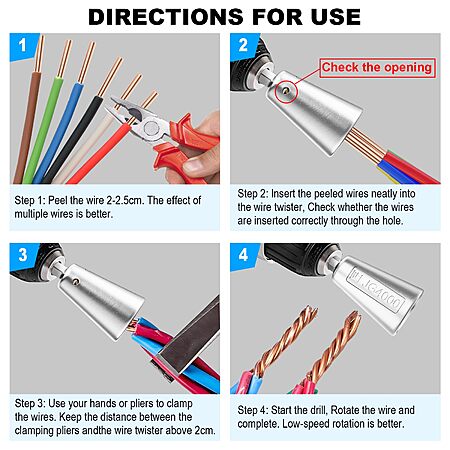Roodiio Direct.Store via Amazon has
2-Count Nooydio Wire Twister Tool for Electrical Power Drill on sale for $9.99 - $5 (50%) off when you apply promo code
EE53KOCL on the checkout page =
$4.99.
Shipping is free w/ Prime or on $35+ orders.
Thanks to Deal Hunter
babgaly for sharing this deal.
About this product:
- This tool twists wires 5x faster than manual methods, for 1.5/2.5/4/6mm² (9-22 AWG) wires to ensures secure, tangle-free connections
- ️Compatibility with 6mm hex shank power drills
- Crafted from 40Cr galvanized steel with electrolytic coating, ensuring extreme hardness, wear resistance, and rust-proof durability
- High-temperature forged 304 stainless steel core resists impact, heat, and corrosion, enduring 35,000+ twists
- Clear observation window to verify wire alignment before twisting, reducing errors
- Ergonomic design prevents hand fatigue and finger injuries
- 4-step operation: 1) strip wires (0.8-9.8") 2) insert into tool (check via window) 3) clamp with pliers (0.8" gap) 4) twist with drill
- Ideal for electricians, automotive, and construction in workshops, garages, or homes





Leave a Comment
Top Comments
I'm a wireman by trade and luckily have only come across some boxes that some dingbat hit with these just once. It took forever to undo all of the connections without (further) damaging things in order to trace things out.
These drill adapters are absolute garbage and I highly discourage anyone from using them. Here's more info from chat which explains it perfectly:
Why You Don't Use a Drill Adapter
Those drill "wire twisters" are pure garbage in real-world work:
They over-torque and stress the copper, especially on 12/10 AWG — micro-fractures show up later as heat or intermittent faults.
They don't align insulation lengths, so you'll get uneven cuts and exposed copper under the cap.
They can nick strands or twist insulation back, leading to a loose or burned connection.
They leave no feel — you can't tell if a wire's short, broken, or already twisted too tight.
Basically, you trade speed for control, and that's not worth it in electrical work where failure = heat or fire.
15 Comments
Sign up for a Slickdeals account to remove this ad.
Our community has rated this post as helpful. If you agree, why not thank jkloisdafoiwdaf
Our community has rated this post as helpful. If you agree, why not thank TrollPatrol
Sign up for a Slickdeals account to remove this ad.
Our community has rated this post as helpful. If you agree, why not thank Sinjin28
I'm a wireman by trade and luckily have only come across some boxes that some dingbat hit with these just once. It took forever to undo all of the connections without (further) damaging things in order to trace things out.
These drill adapters are absolute garbage and I highly discourage anyone from using them. Here's more info from chat which explains it perfectly:
Why You Don't Use a Drill Adapter
Those drill "wire twisters" are pure garbage in real-world work:
They over-torque and stress the copper, especially on 12/10 AWG — micro-fractures show up later as heat or intermittent faults.
They don't align insulation lengths, so you'll get uneven cuts and exposed copper under the cap.
They can nick strands or twist insulation back, leading to a loose or burned connection.
They leave no feel — you can't tell if a wire's short, broken, or already twisted too tight.
Basically, you trade speed for control, and that's not worth it in electrical work where failure = heat or fire.
To twist or not to twist, that is the question. Under a wire nut tis nobler to leave straight?
You want to twist the wires together, they lock together and the spring on top of the wire nut digs into the conductor and maintains tension giving you a good, solid connection.
I'm a wireman by trade and luckily have only come across some boxes that some dingbat hit with these just once. It took forever to undo all of the connections without (further) damaging things in order to trace things out.
These drill adapters are absolute garbage and I highly discourage anyone from using them. Here's more info from chat which explains it perfectly:
Why You Don't Use a Drill Adapter
Those drill "wire twisters" are pure garbage in real-world work:
They over-torque and stress the copper, especially on 12/10 AWG — micro-fractures show up later as heat or intermittent faults.
They don't align insulation lengths, so you'll get uneven cuts and exposed copper under the cap.
They can nick strands or twist insulation back, leading to a loose or burned connection.
They leave no feel — you can't tell if a wire's short, broken, or already twisted too tight.
Basically, you trade speed for control, and that's not worth it in electrical work where failure = heat or fire.
I'm a wireman by trade and luckily have only come across some boxes that some dingbat hit with these just once. It took forever to undo all of the connections without (further) damaging things in order to trace things out.
These drill adapters are absolute garbage and I highly discourage anyone from using them. Here's more info from chat which explains it perfectly:
Why You Don't Use a Drill Adapter
Those drill "wire twisters" are pure garbage in real-world work:
They over-torque and stress the copper, especially on 12/10 AWG — micro-fractures show up later as heat or intermittent faults.
They don't align insulation lengths, so you'll get uneven cuts and exposed copper under the cap.
They can nick strands or twist insulation back, leading to a loose or burned connection.
They leave no feel — you can't tell if a wire's short, broken, or already twisted too tight.
Basically, you trade speed for control, and that's not worth it in electrical work where failure = heat or fire.
Sign up for a Slickdeals account to remove this ad.
Leave a Comment